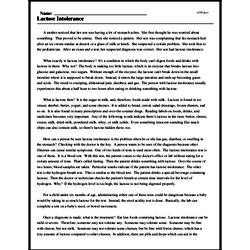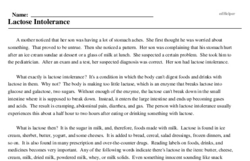Lactose Intolerance
A mother noticed that her son was having a lot of stomach aches. She first thought he was worried about something. That proved to be untrue. Then she noticed a pattern. Her son was complaining that his stomach hurt after an ice cream sundae at dessert or a glass of milk at lunch. She suspected a certain problem. She took him to the pediatrician. After an exam and a test, her suspected diagnosis was correct. Her son had lactose intolerance.
What exactly is lactose intolerance? It's a condition in which the body can't digest foods and drinks with lactose in them. Why not? The body is making too little lactase, which is an enzyme that breaks lactose into glucose and galactose, two sugars. Without enough of the enzyme, the lactose can't break down in the small intestine where it is supposed to break down. Instead, it enters the large intestine and ends up becoming gases and acids. The result is cramping, abdominal pain, diarrhea, and gas. The person with lactose intolerance usually experiences this about a half hour to two hours after eating or drinking something with lactose.
What is lactose then? It is the sugar in milk, and, therefore, foods made with milk. Lactose is found in ice cream, sherbet, butter, yogurt, and some cheeses. It is added to bread, cereal, salad dressings, frozen dinners, and so on. It is also found in many prescription and over-the-counter drugs. Reading labels on foods, drinks, and medicines becomes very important. Any of the following words indicate there's lactose in the item: butter, cheese, cream, milk, dried milk, powdered milk, whey, or milk solids. Even something innocent sounding like snack chips can also contain milk, so there's lactose hidden there, too.




